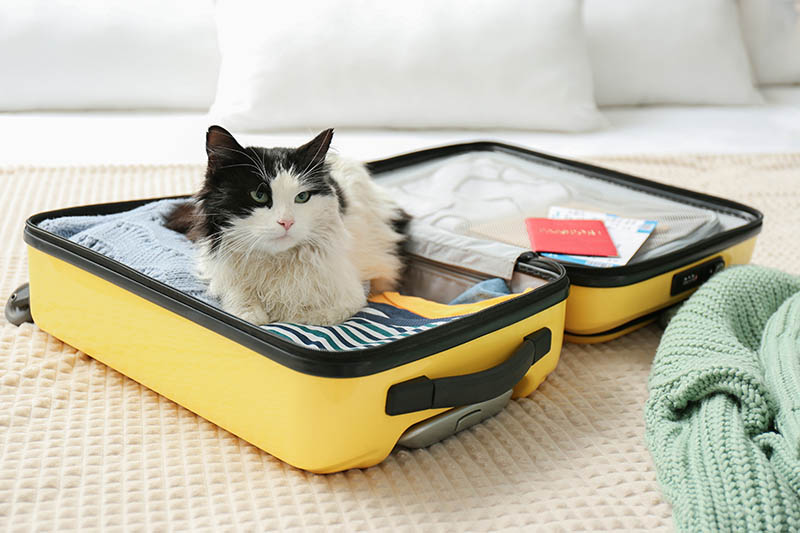5 Ways to Protect Carpet From Cats: Expert Tips & Tricks
By Hallie Roddy
Updated on

The benefits of owning a cat are far greater than the disadvantages. Cat claws are one of the few disadvantages that can leave pet owners feeling beyond frustrated. After spending so much money on plush carpeting, it doesn’t take long for our cats to sink their claws into it and damage it.
Stopping your cats from scratching up your carpet can be difficult or straightforward—it all depends on the individual. Some cats scratch continuously throughout the day, and others don’t seem to use their claws much at all. Regardless, it helps to determine why your cat scratches carpeting and how to protect your carpet from your little lion.
Why Cats Scratch Carpeting
There are multiple reasons for a cat’s scratching behavior. As a cat owner, understand that this is an instinctual need and not something they do to bother you. Scratching keeps a cat’s nails honed and helps them mark their territory because of the glands between their toes.
Cats even scratch carpeting simply because they’re in a playful mood! Knowing why your cat feels the need to scratch is crucial because you can then implement strategies to protect your carpet and deflect the behavior elsewhere.
The 5 Ways to Protect Carpet from Cats
1. Add More Scratching Solutions
There is no way around the fact that cats need to scratch. However, there are ways to prevent them from scratching items in the house—like your carpeting—that you would prefer to stay in pristine condition. The easiest way to prevent them from messing up the carpet is to provide plenty of other safe options.
Scratching posts are the best and most obvious example we can provide. There are plenty of shapes, designs, and colors available to fit the aesthetic of your home. They range from cheap to expensive to fit any budget. Try to keep at least one scratching post in each room of the house that they have access to for the most success. The more scratching posts available to your cat, the less likely they will use your carpet as one!
Better yet, try to use as many unique shapes and textures as possible. If you can provide them with a traditional post, a scratching pad that lays flat, and one that mounts to the wall, you will have even more success protecting your carpet.
2. Cover the Carpet
If you’ve already provided multiple places for your cat to scratch, and they continue to use the carpet, you might consider covering the area. Cats sometimes scratch repeatedly in the same spot out of habit, but you can help them break the habit.
To break the cycle, try moving furniture over the areas where they like the scratch. If that is not possible, any flat, horizontal material, like a large piece of cardboard, can also be helpful. This might not prevent the habit altogether but will save your carpet in the long run.
3. Keep Your Cat’s Claws Trimmed
Cat claws grow rapidly, and some cats may be scratching more frequently because of how fast their nails grow. Because they scratch carpets to keep their nails healthy, you can help them by trimming their nails regularly.
It might take a little time for your cat to adjust to the trimming process. Your first few attempts likely won’t go smoothly, but they should grow accustomed over time, and the scratching should decrease.
Keeping your cat's nails trimmed can help you protect your home from scratching damage. With a great set of clippers like our Hepper Cat Nail Clipper Set, you'll be able to easily and safely trim your cat's claws whenever you need to. This set includes two pairs of clippers, both with stainless steel blades, safety guards, and locking switches. You'll also get a built-in nail file and a pouch for easy storage.
4. Reduce Anxiety
Some of the more anxious felines resort to scratching the carpet to reduce stress and nervousness. Take as many steps as possible to reduce your cat’s anxiety. If they are new to the home, make sure that you introduce them to the new space slowly and one room at a time.
For cats that have been around for a while, try to find out what has triggered their stress and remove it as soon as possible. If neither works, you can purchase sprays and plug-ins that release pheromones that help calm your cat.
5. Prevent Further Habits From Forming
Prevention is always the best medicine when it comes to cat behavior. Teach your cat that scratching the carpet is unacceptable as early as possible. Encourage them to use scratching posts early on in order to keep them from using the carpet. Cats are unlikely to switch their go-to spot for no reason.

Is Declawing an Option?
Some first-time cat owners assume that declawing their cats is the best option for protecting their carpets and furniture. However, we do not recommend it. Think of declawing your cat as the equivalent of removing the tips of your fingers. Not only is the declawing procedure painful, but it is unnecessary and limits your cat’s capabilities.
Cats that have gone through the declawing procedure sometimes need to learn how to walk again and do other simple tasks they once could, such as climbing. Besides, it doesn’t treat the underlying problem. Claws are your cat’s biggest weapon, and removing them is a tremendous disservice.
Conclusion
We understand how frustrating it can be when your cat destroys your carpet. Thankfully, there are plenty of small steps you can take to encourage them to go somewhere else. You might be unable to stop their scratching completely, but you can protect your belongings from their sharp claws. Once they are used to the new routine, you shouldn’t have a problem keeping your carpets intact.
Featured Image Credit: Maliflower73, Shutterstock














